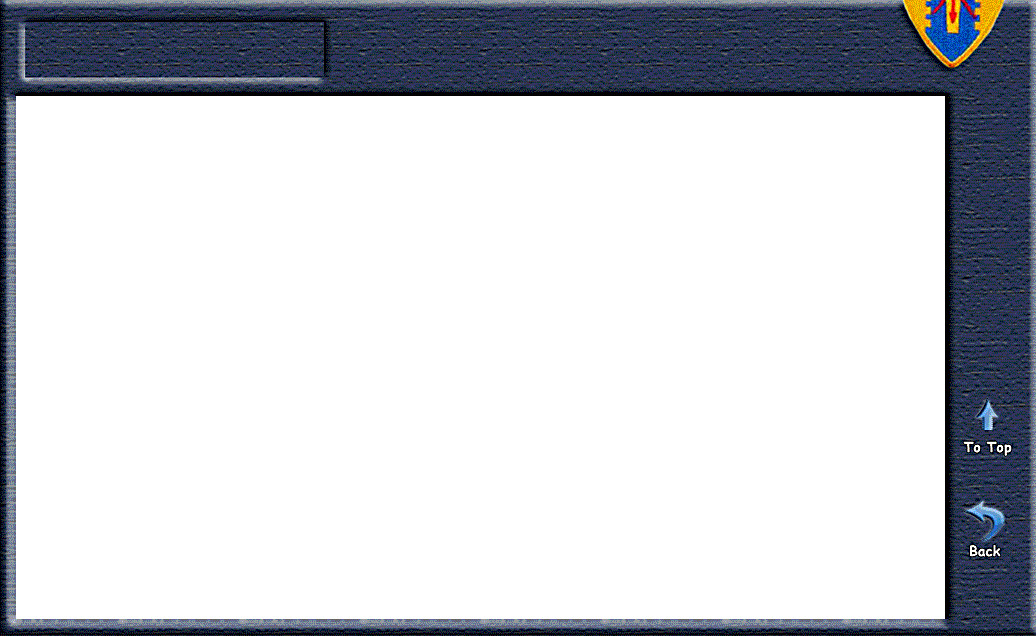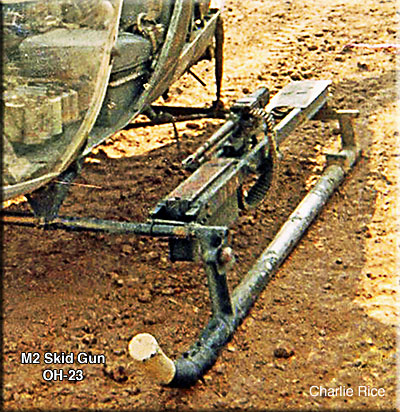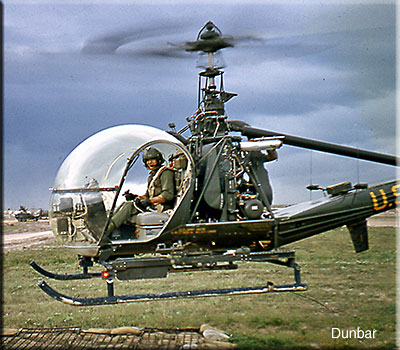

Discussion and stories of the very first Scout helicopters of the Centaurs.
Bob Graham, Tom Fleming, Bruce Powell, Walter Cooke, Buck Buxton, Byrd & Dunbar, OH-23 Stories
also see History Section OH-23G
Bob Graham: MAJ, 1966-67;
 The first issue of OH-23’s during April-May 1966 were initially armed with the M-2 twin 7.62 Cal Machine gun for the light scouts of D Troop. The reliability of the system became questionable. The light scouts had intermittent success with the system while scouting and as very light fire support. Under MAJ Rudy Pick (initial Scout Section leader) they did not develop any recon by fire techniques and from my view used the weapon only when they had first been engaged by the VC.
The first issue of OH-23’s during April-May 1966 were initially armed with the M-2 twin 7.62 Cal Machine gun for the light scouts of D Troop. The reliability of the system became questionable. The light scouts had intermittent success with the system while scouting and as very light fire support. Under MAJ Rudy Pick (initial Scout Section leader) they did not develop any recon by fire techniques and from my view used the weapon only when they had first been engaged by the VC.
About the time that MAJ Jim Peterson (late June 1966) took command of the troop he expressed his concern about the systems reliability and the untenable situations that might develop during its employment. CPT Frank Delvy [then in the heavy scouts] and I [then in the weapons section] were tasked to conduct a rudimentary reliability experiment.
A brief standardized maintenance and bore sighting exercise was implemented.
Each crew prepared their OH-23. Then the pilots fired the system in a none-tactical situation or at some targets we had placed beyond the north perimeter (later became known as Ann Margaret). The pneumatic charging system would often cycle properly and the gun still not fire. An unfired cartridge would be ejected and often the gun would not fire again. It was not uncommon to repeat the cycle a number of times. Often neither gun fired. CPT Delvy and my assessment for MAJ Peterson was that the reliability over all the OH-23’s was that about 50% of the time only one gun would fire on the first try. On about 25% of the firing runs neither gun would fire on the first try. Worst of all the failures were quite random.
 Then WO Bob Dunbar had his confrontation with a VC in a Sampan in the area to the north east of Cu Chi that had numerous swamps and tributaries to the Saigon River. My recall (confirmed by a recent phone call) was that he was doing a low level scouting recon along a narrow waterway. At close range an individual in a sampan whipped out a carbine, Dunbar tried to zap him with his M-2’s. They did not fire so he literal overran the guy, knocking him from the sampan. He then followed up with his acquired Swedish K (38 caliber pistol ammo firing sub machine gun) firing with his left hand while flying with his right and zapped the VC. MAJ Peterson admired WO Dunbar’s fearless attitude but did not encourage it as a common tactic.
Then WO Bob Dunbar had his confrontation with a VC in a Sampan in the area to the north east of Cu Chi that had numerous swamps and tributaries to the Saigon River. My recall (confirmed by a recent phone call) was that he was doing a low level scouting recon along a narrow waterway. At close range an individual in a sampan whipped out a carbine, Dunbar tried to zap him with his M-2’s. They did not fire so he literal overran the guy, knocking him from the sampan. He then followed up with his acquired Swedish K (38 caliber pistol ammo firing sub machine gun) firing with his left hand while flying with his right and zapped the VC. MAJ Peterson admired WO Dunbar’s fearless attitude but did not encourage it as a common tactic.
MAJ Peterson felt that all the M-2’s should be removed and stressed an armed observer on all scouting missions.
The M-2’s did not disappear as he initially directed. With some considerable discussion with MAJ Peterson we began a systematic quality control approach. Everyone in the scout section under MAJ Rudy Pick the scout section leader including the 725th Maintenance Company began to systematically cull out the unreliable weapon combinations. For quite some time there were a number of OH-23’s without armament. Often just the guns would be removed for a short period as tinkering continued. These impotent OH-23’s were dispatched for convoy and coordination and transporting ground element commander or liaison. As time passed there always seemed to be a few unarmed OH-23’s. What appeared in the beginning to be a really simple system could be quirky and difficult to finely tune to a high level of reliability.
Tom Fleming: MAJ Service Platoon & Troop Cdr, 1967-68;
I arrived at D Troop in early February 1967. I was surprised at that time that the OH-23 was not armed and not being used in what I believed was the role the light scouts were capable of. I know how light scouts were being used in 1/9 Cav and other units in VN.
As the Service Platoon Cdr. I had to keep my mouth shut. I remember Bruce Powell approaching me in the mess hall pleading with me to use my influence with the Troop Cdr to let the light scouts do what they were designed for. I remember telling him I had to stay out of the issue, but that he was on spot with the issue. His discussion with me spurred me in to becoming vocal on the issue.
The Scout Platoon Section Ldr, Ernie Sanders and I, went at it hotly so much that when it was announced I was to take over the troop from MAJ Thoreson, Sanders went to him telling him he could not lead the Light Scouts with me in command. He asked to move to the Aerorifles as a UH-1 pilot. I told MAJ Thoreson that I was fine with that.
In October/November '67 after bitching to Squadron about the line troops missing the boat by not trusting the Light Scouts to do direct support for them in their movements an maneuvers cross country and in search and destroy operations the Sqdn XO MAJ Hertford had A, B, & C Troops send over 2 each scouts for aerial observer training and utilization on Aero Scout missions. As I recall we got scouts from A & B Troops and none from C. TheLight Scouts worked with them to be a third gunner and scout observer for several weeks or maybe a month. They didn't work out. First of all they didn't send their best scouts that they would have confidence in and the individuals who came couldn't read a map and weren't able to stay oriented. It was a good concept that didn't work. There may have been one or two that did work out and if so and they stuck with us we should acknowledge their service to D Troop.
I wasn't the author of flying Engineer Officers on First Light MSR Surveillance mission (another program that didn't work). When I first arrived I heard the grumbling from the pilots that they were just taking up space getting Air Medal time. That all came to an abrupt end when one of them flying with Walt Baum was told to fire on a VC who Popped up on his side in the free fire zone by Trang Bang. Apparently the Engineer froze letting the VC shoot him hitting him in his femoral artery. Walt raced him to 12th evac, but he had pumped out all his blood on the way there. The first I knew of it was in the Corral an OH-23 was landing and its bubble was all opaque. I walked over and was about to chew the pilot out for painting up the bubble like a clown ship when I looked in the cockpit and saw Walt sitting there shaking with blood dripping off his face I backed off and got some crew chiefs to help him out and clean up all the blood that had splattered all over the inside of the bubble.
Bruce Powell: 1LT Scout Pilot 1967;
Our standing orders were to stay above 1500 feet altitude and not engage the enemy. However, a lot of hairy things happened on those simple, single ship, "Recon the MSR" for damage" missions.
I took my turn at flying those missions in February of 1967. It was boring, just like flying an artillery observer in seemingly unending circles (fell asleep one time in orbit and scared the crap out of both of us. Must have been one of those 12hr days).
It was almost a different Engineer guy every time. It was a little frustrating that they wouldn't just train someone for that mission instead of trying to collect air medals for all of them.
We would invariably find big holes in the MSR. I would circle low, he would use binoculars, a map and some other items to send back specific data to his unit. The Engr unit could then accurately plan the days work of repairing the route. The convoy commander could be notified as to when he could depart and not get held up on the MSR while a bigger than estimated hole was being repaired. It all sounded logical.
When an Engineer wasn't available we would fly the mission anyway and tell their headquarters how many big holes and how many little holes and where they were. Seemed to work okay.
My main issue (this was before I realized that a person could get hurt doing this), was to convince the Engr of the day to help me in my (made up) mission of securing enemy personnel for interrogation. We would conclude our road mission at Tay Ninh and prepare to come home. I would explain that we periodically needed to recon the Cambodian border on our way back and possibly pick up suspects. Most were okay with the low level recon of the Border, but not the Stickem Up (physically capture people).
The first guy that I got to buy into that was really gung ho and seemed happy to be doing something more like war than estimating hole sizes. However, he did seem more concerned about my nicking the tops of trees with my skids at high speeds than he was with looking for enemy.
I spotted a group trying to hide in the brush and did a return to target maneuver and flushed them out. Upon landing the Engineer, in the right seat, was away from the group; My 12 gauge shot gun was trained out the left side on the group. It took a while for the Engr to get is stomach settled from the unearthly landing procedure.
"Watch out for the rotor blades when you get out to search them", I said. That caused a very long pause. "Come on let's get it done. I'll cover you". "Take this rope and tie the hands of the younger one and walk him back here. Stay out of my line of fire. Bring any satchels or other things like that". Damned if he didn't do it! The suspect VC was strapped in my left seat with his feet also tied. We got out of there fast. I had the Engr mark the coordinates (he was good with the map).
I had not been in to Trung Lap before, but someone had told me that I could take prisoners there to the ARVN Rangers and not get into trouble. It seemed to work well.
Do you think that story is beyond the pale? Check out the Tropic Lightning entry in our own Timeline section of the our website: Aug 21, 1967 TropicLightningNews.
My experiences of working with the other Troops, particularly A Troop were great. We used to fight to get assigned that mission rather than flying the boring MSR mission. It was almost always that the Troop Commander or his XO that would fly with me. Periodically a squad leader, but always someone who knew what they were doing and had the confidence of the Troop. On some missions they would brief me and send me out alone. It was a great feeling having the confidence of a Troop Commander.
Our mission was different then, truly the support role of an unarmed aircraft. Once I left for the gun platoon they started arming with skid guns, and things changed.
The new Squadron Commander Col Jack Shea, who trained with the 1/9th CAV, was persuaded by the new D Troop Commander Tom Fleming (and others) to arm the OH-23's and start using them in the war. Tom or George Stenejham can straighten us out on that timeline. So the lowly unarmed, single ship, ash and trash, 6 cylinder, gas driven, OH-23 became a true low level hand to hand combat aircraft. They could now do what many of us were doing before, but do it with increased confidence and the blessing of the chain of command, and in pairs, a team.
The Engineers flying with us on "First Light" missions ceased after an engineer CPT was killed riding with Walt Baum. Others of you need to retell that story.
The new OH-6 followed in that role with it's jet engine, speed, agility, crash survivability, a minigun and a door gunner. Wow! The scout team of the OH-6 low and the AH-1G Cobra high became the new standard for Scouting; the "Hunter-Killer Team". .....Bruce
Walter Cooke: CW2 OH-23 Scout Pilot 1966-67;
My first tour was with 725th Maintenance from June/66 to June/67. I distinctly remember working on 23’s with gun mounts. Now, did they belong to D Troop? I can’t remember those details.
I've been reading the recent on the guns on the 23's and they are very interesting. Sounds like I missed out on the ' beginnings ' of the 'gun era' with 23's.
I did fly them before I came to the 3/4. I was with Hq & Hq Co. of the 2nd Brigade and had no guns. Always flew alone except with a Battalion CO, flying command and control. As, I think I mentioned, somewhat boring, no defense when receiving fire, but got to know the AO and the people very well; a benefit when I came over to the Cav.
When I got to the Cav the 23's had an m-60 fixed on the left skid, crew chief in the right door with an m60 and an enlisted observer in the left door with an M79. Then grenades, smoke and willy peat grenades hanging all over the place. God help us if we lost an engine the first 30 mins of flight (slightly overloaded). We weren’t the fastest and I suppose not very impressive but it seemed, at least to me, a very effective application overall.
When we, the Light Scouts, went to the OH-6 we lost the observer but gained the mini gun on the left side and still had the crew chief in the right door. The 'LOH' was a bit faster, infinitly more manuverable, and the mini gun, well it speaks for itself. The main drawback to the manuverability was if the 'pucker factor' rose to high and you got 'heavy' with the collective you had about 15 seconds till the oil chips light for the transmission came on. Other than that they were one hell of an aircraft. Shoot, look at what they are doing with them today. ...Walter
Buck Buxton: 1LT Maintenance Off 1967-68;
When I only had a few days left in country, 29 Jan 67, I flew wing on a scout mission for Walt Baum in a 23.
We got up two VC running across a rice patty near Trang Bang. Walt killed one and I chased the other across
the field and when I engaged with the skid guns they jammed. Cpt Stone and a squad of infantry
came and picked him. When Stone hovered over to the dead guy the entire woods erupted.
He was regular NVA. A fun morning for short timer ! ....Buck
Dwight Byrd & Bob Dunbar Light Scout Stories
Copters in Vietnam - Dawn Patrol